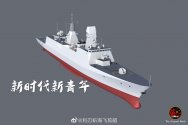It's more about diminishing capabilities in terms of updating and tracking than coverage as I understand it. Rotating arrays' search and track update times are quantized and so the track initiation process is more constrained than fixed arrays. So naturally they have lower performance in tracking especially against fast-moving and crossing targets. In addition, fewer arrays and fewer "window" makes beam scheduling harder. There's also the problem of not having nearly as good overlapping coverage between arrays to make up for the diminishing performance of sidelobes.If I understand this correct, a spinning radar provides you with 360 degree coverage while only using two panels which makes it a cost effective solution. The downside is that since the radar is spinning, it is technically doesn't provide the same tracking capability/capacity as having four panels for "true" 360 degree coverage?
You do get some major benefits however especially on frigates like 054B as rotating twin panels allow for a much larger array without making the vessel top-heavy. It's a trade worth taking presumably for extended detection range for longer-range missiles (HQ16F vs HQ16). In any case, there's the rapid response radar on aft mast to support the main arrays.

